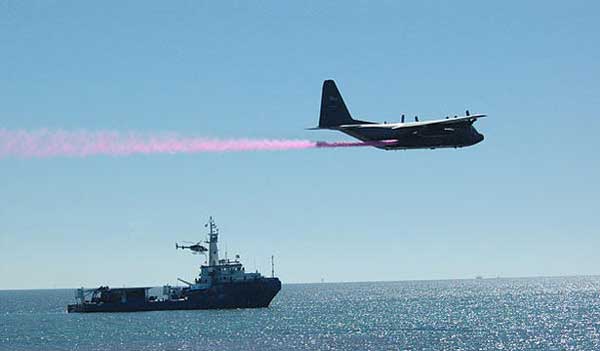What Are We Dumping Into The Gulf To ‘Fix’ The Oil Spill?
By Tom Philpott
04 May, 2010
Grist.org

A 2006 oil-dispersant-spraying test run by the Air Force Reserve Command’s 910th Airlift Wing, currently deployed to the Gulf to support the oil spill recovery effort.
(U.S. Air Force file photo)
In addition to the indignity of oil oozing into its depths at a rate of at least 5,000 barrels per day, the Gulf of Mexico is now enduring a heavy rain of mystery chemicals.
BP and the U.S. Coast Guard are dumping large amounts of "dispersants" both on the surface and underwater, in a desperate attempt to control the ongoing spill. Dispersants are surfactants, not unlike what you use on your dishes, that break oil down into small droplets that sink into the water. .
How much are they dumping? Lots. According to ProPublica, "BP has already bought up more than a third of the world's supply" of dispersants. On Thursday alone, ProPublica reports, emergency workers dropped 100,000 gallons of the stuff into the Gulf.
And what precisely are they dumping? That's where the mystery comes in. "The exact makeup of the dispersants is kept secret under competitive trade laws," Propublica reports.
What? Let me get this straight. A huge oil company is pumping massive amounts of oil directly into public waters, imperiling the health of some of the globe's most productive fisheries -- as well as communities around the coast. To try to minimize the effects of the ongoing spill, the company starts dumping chemicals into that same public water. And not just a little -- a third of the global supply is on hand. And we don't have the right to know what those chemicals are? That's a scandal.
Propublica did manage to identify one product currently being used, called Corexit, which includes 2-butoxyethanol, a "compound associated with headaches, vomiting and reproductive problems at high doses."
Before we get to the possible toxic effects of this chemical cascade, let's ponder dispersants as a practical strategy for controlling the effects of a huge spill. BP has created a monstrous dilemma. Left to linger at the ocean surface undisturbed, oil forms a massive slick, which devastates coastal areas. That is already happening. The more oil that gushes out, the bigger that slick gets, and the more damage at the coast.
The dispersant strategy seeks to limit coastal damage by moving oil from the surface to the ocean's depths, where it remains stationary and can't drift to the coast. Of course, the ecological burden of the spill is pushed below the surface -- with potentially devastating consequences.
The strategy is controversial among marine biologists. In 2005, the National Academies Press published a book on the topic, available for online reading, authored by the Ocean Studies Board. The report reveals that serious questions remain about the wisdom of using dispersants to treat spills.
The report states that most research on how fish deal with chemically dispersed oil don't account for how sunlight might magnify ill effects. The report puts it like this:
[T]he possibility of photoenhanced toxicity and particulate/oil droplet phase exposure is generally not considered. A number of laboratory studies have indicated toxicity due to PAH increases significantly (from 12 to 50,000 times) for sensitive species in exposures conducted under ultraviolet light (representative of natural sunlight), compared to those conducted under the more traditional laboratory conditions of fluorescent lights.
In other words, most tests have been done under lab conditions; but when you perform them in actual sea conditions -- ie, with the sun shining -- things look considerably worse. That's a chilling thought, given what is now happening in the Gulf.
Scandinavia has had its share of oil spills over the years, so I contacted Hans Ulrik Riisgård, professor at the Marine Biological Research Centre at the University of Southern Denmark, to get his perspective on dispersants. Putting the matter of possible toxicity of the dispersants aside, Riidgard replied via email that that dispersants remove oil from the sea surface rapidly, "making the oil concentration many times higher than it would have been due to natural dispersal (wave action etc.)."
He continued: "Therefore, use of dispersants will most often lead to a much larger exposure of marine organisms to oil, resulting in more pronounced toxic effects on sea life."
Propublica quotes U.S.-based expert Richard Charter -- a senior policy advisor for marine programs for Defenders of Wildlife and a "foremost expert on marine biology and oil spills" -- to the same effect. "It's a tradeoff -- you're damned if you do, damned if you don't -- of trying to minimize the damage coming to shore, but in so doing you may be more seriously damaging the ecosystem offshore," he said.
And what about the toxicity of the dispersants? Riisgard and Charter have different views. "The 'second' and 'third generations' of dispersants are not toxic," Riisgard wrote in his email. I'd like to assume that authorities in the Gulf are using nontoxic dispersants; it would be nice if they would disclose that information.
I have an email into Riisgard asking him whether he considers 2-butoxyethanol, the one dispersant identified by Propublica, as nontoxic. He hasn't responded yet.
Charter, meanwhile, has another perspective. "There is a chemical toxicity to the dispersant compound that in many ways is worse than oil," he told Propublica. I am currently trying to reach Charter for more commentary.
The controversy over dispersants, into which I'll be digging more deeply over the next few days, underlines just how brutal a blow the oil spill has dealt to a vital food-producing ecosystem.

